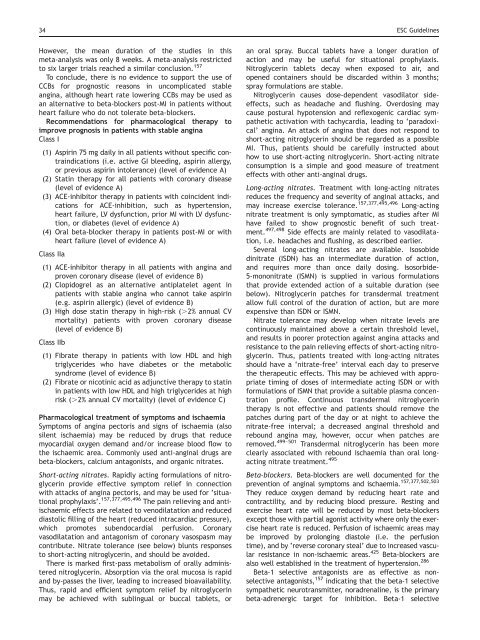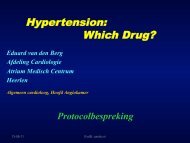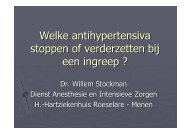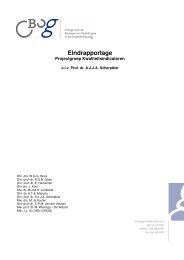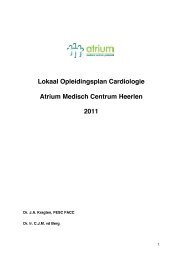Guidelines on the Management of Stable Angina Pectoris ... - Cardio
Guidelines on the Management of Stable Angina Pectoris ... - Cardio
Guidelines on the Management of Stable Angina Pectoris ... - Cardio
You also want an ePaper? Increase the reach of your titles
YUMPU automatically turns print PDFs into web optimized ePapers that Google loves.
34 ESC <str<strong>on</strong>g>Guidelines</str<strong>on</strong>g>However, <strong>the</strong> mean durati<strong>on</strong> <strong>of</strong> <strong>the</strong> studies in thismeta-analysis was <strong>on</strong>ly 8 weeks. A meta-analysis restrictedto six larger trials reached a similar c<strong>on</strong>clusi<strong>on</strong>. 157To c<strong>on</strong>clude, <strong>the</strong>re is no evidence to support <strong>the</strong> use <strong>of</strong>CCBs for prognostic reas<strong>on</strong>s in uncomplicated stableangina, although heart rate lowering CCBs may be used asan alternative to beta-blockers post-MI in patients withou<strong>the</strong>art failure who do not tolerate beta-blockers.Recommendati<strong>on</strong>s for pharmacological <strong>the</strong>rapy toimprove prognosis in patients with stable anginaClass I(1) Aspirin 75 mg daily in all patients without specific c<strong>on</strong>traindicati<strong>on</strong>s(i.e. active GI bleeding, aspirin allergy,or previous aspirin intolerance) (level <strong>of</strong> evidence A)(2) Statin <strong>the</strong>rapy for all patients with cor<strong>on</strong>ary disease(level <strong>of</strong> evidence A)(3) ACE-inhibitor <strong>the</strong>rapy in patients with coincident indicati<strong>on</strong>sfor ACE-inhibiti<strong>on</strong>, such as hypertensi<strong>on</strong>,heart failure, LV dysfuncti<strong>on</strong>, prior MI with LV dysfuncti<strong>on</strong>,or diabetes (level <strong>of</strong> evidence A)(4) Oral beta-blocker <strong>the</strong>rapy in patients post-MI or withheart failure (level <strong>of</strong> evidence A)Class IIa(1) ACE-inhibitor <strong>the</strong>rapy in all patients with angina andproven cor<strong>on</strong>ary disease (level <strong>of</strong> evidence B)(2) Clopidogrel as an alternative antiplatelet agent inpatients with stable angina who cannot take aspirin(e.g. aspirin allergic) (level <strong>of</strong> evidence B)(3) High dose statin <strong>the</strong>rapy in high-risk (.2% annual CVmortality) patients with proven cor<strong>on</strong>ary disease(level <strong>of</strong> evidence B)Class IIb(1) Fibrate <strong>the</strong>rapy in patients with low HDL and hightriglycerides who have diabetes or <strong>the</strong> metabolicsyndrome (level <strong>of</strong> evidence B)(2) Fibrate or nicotinic acid as adjunctive <strong>the</strong>rapy to statinin patients with low HDL and high triglycerides at highrisk (.2% annual CV mortality) (level <strong>of</strong> evidence C)Pharmacological treatment <strong>of</strong> symptoms and ischaemiaSymptoms <strong>of</strong> angina pectoris and signs <strong>of</strong> ischaemia (alsosilent ischaemia) may be reduced by drugs that reducemyocardial oxygen demand and/or increase blood flow to<strong>the</strong> ischaemic area. Comm<strong>on</strong>ly used anti-anginal drugs arebeta-blockers, calcium antag<strong>on</strong>ists, and organic nitrates.Short-acting nitrates. Rapidly acting formulati<strong>on</strong>s <strong>of</strong> nitroglycerinprovide effective symptom relief in c<strong>on</strong>necti<strong>on</strong>with attacks <strong>of</strong> angina pectoris, and may be used for ‘situati<strong>on</strong>alprophylaxis’. 157,377,495,496 The pain relieving and antiischaemiceffects are related to venodilatati<strong>on</strong> and reduceddiastolic filling <strong>of</strong> <strong>the</strong> heart (reduced intracardiac pressure),which promotes subendocardial perfusi<strong>on</strong>. Cor<strong>on</strong>aryvasodilatati<strong>on</strong> and antag<strong>on</strong>ism <strong>of</strong> cor<strong>on</strong>ary vasospasm mayc<strong>on</strong>tribute. Nitrate tolerance (see below) blunts resp<strong>on</strong>sesto short-acting nitroglycerin, and should be avoided.There is marked first-pass metabolism <strong>of</strong> orally administerednitroglycerin. Absorpti<strong>on</strong> via <strong>the</strong> oral mucosa is rapidand by-passes <strong>the</strong> liver, leading to increased bioavailability.Thus, rapid and efficient symptom relief by nitroglycerinmay be achieved with sublingual or buccal tablets, oran oral spray. Buccal tablets have a l<strong>on</strong>ger durati<strong>on</strong> <strong>of</strong>acti<strong>on</strong> and may be useful for situati<strong>on</strong>al prophylaxis.Nitroglycerin tablets decay when exposed to air, andopened c<strong>on</strong>tainers should be discarded within 3 m<strong>on</strong>ths;spray formulati<strong>on</strong>s are stable.Nitroglycerin causes dose-dependent vasodilator sideeffects,such as headache and flushing. Overdosing maycause postural hypotensi<strong>on</strong> and reflexogenic cardiac sympa<strong>the</strong>ticactivati<strong>on</strong> with tachycardia, leading to ‘paradoxical’angina. An attack <strong>of</strong> angina that does not resp<strong>on</strong>d toshort-acting nitroglycerin should be regarded as a possibleMI. Thus, patients should be carefully instructed abouthow to use short-acting nitroglycerin. Short-acting nitratec<strong>on</strong>sumpti<strong>on</strong> is a simple and good measure <strong>of</strong> treatmenteffects with o<strong>the</strong>r anti-anginal drugs.L<strong>on</strong>g-acting nitrates. Treatment with l<strong>on</strong>g-acting nitratesreduces <strong>the</strong> frequency and severity <strong>of</strong> anginal attacks, andmay increase exercise tolerance. 157,377,495,496 L<strong>on</strong>g-actingnitrate treatment is <strong>on</strong>ly symptomatic, as studies after MIhave failed to show prognostic benefit <strong>of</strong> such treatment.497,498 Side effects are mainly related to vasodilatati<strong>on</strong>,i.e. headaches and flushing, as described earlier.Several l<strong>on</strong>g-acting nitrates are available. Isosobidedinitrate (ISDN) has an intermediate durati<strong>on</strong> <strong>of</strong> acti<strong>on</strong>,and requires more than <strong>on</strong>ce daily dosing. Isosorbide-5-m<strong>on</strong><strong>on</strong>itrate (ISMN) is supplied in various formulati<strong>on</strong>sthat provide extended acti<strong>on</strong> <strong>of</strong> a suitable durati<strong>on</strong> (seebelow). Nitroglycerin patches for transdermal treatmentallow full c<strong>on</strong>trol <strong>of</strong> <strong>the</strong> durati<strong>on</strong> <strong>of</strong> acti<strong>on</strong>, but are moreexpensive than ISDN or ISMN.Nitrate tolerance may develop when nitrate levels arec<strong>on</strong>tinuously maintained above a certain threshold level,and results in poorer protecti<strong>on</strong> against angina attacks andresistance to <strong>the</strong> pain relieving effects <strong>of</strong> short-acting nitroglycerin.Thus, patients treated with l<strong>on</strong>g-acting nitratesshould have a ‘nitrate-free’ interval each day to preserve<strong>the</strong> <strong>the</strong>rapeutic effects. This may be achieved with appropriatetiming <strong>of</strong> doses <strong>of</strong> intermediate acting ISDN or withformulati<strong>on</strong>s <strong>of</strong> ISMN that provide a suitable plasma c<strong>on</strong>centrati<strong>on</strong>pr<strong>of</strong>ile. C<strong>on</strong>tinuous transdermal nitroglycerin<strong>the</strong>rapy is not effective and patients should remove <strong>the</strong>patches during part <strong>of</strong> <strong>the</strong> day or at night to achieve <strong>the</strong>nitrate-free interval; a decreased anginal threshold andrebound angina may, however, occur when patches areremoved. 499–501 Transdermal nitroglycerin has been moreclearly associated with rebound ischaemia than oral l<strong>on</strong>gactingnitrate treatment. 495Beta-blockers. Beta-blockers are well documented for <strong>the</strong>preventi<strong>on</strong> <strong>of</strong> anginal symptoms and ischaemia. 157,377,502,503They reduce oxygen demand by reducing heart rate andc<strong>on</strong>tractility, and by reducing blood pressure. Resting andexercise heart rate will be reduced by most beta-blockersexcept those with partial ag<strong>on</strong>ist activity where <strong>on</strong>ly <strong>the</strong> exerciseheart rate is reduced. Perfusi<strong>on</strong> <strong>of</strong> ischaemic areas maybe improved by prol<strong>on</strong>ging diastole (i.e. <strong>the</strong> perfusi<strong>on</strong>time), and by ‘reverse cor<strong>on</strong>ary steal’ due to increased vascularresistance in n<strong>on</strong>-ischaemic areas. 425 Beta-blockers arealso well established in <strong>the</strong> treatment <strong>of</strong> hypertensi<strong>on</strong>. 286Beta-1 selective antag<strong>on</strong>ists are as effective as n<strong>on</strong>selectiveantag<strong>on</strong>ists, 157 indicating that <strong>the</strong> beta-1 selectivesympa<strong>the</strong>tic neurotransmitter, noradrenaline, is <strong>the</strong> primarybeta-adrenergic target for inhibiti<strong>on</strong>. Beta-1 selective


